Strategic Analysis Report: University of Wollongong - MGNT910
VerifiedAdded on 2023/06/13
|20
|4907
|374
Report
AI Summary
This report presents a strategic analysis of the University of Wollongong (UOW), examining both its internal and external environments. The internal analysis identifies strengths and weaknesses, while the external analysis employs Porter’s Five Forces and PESTLE frameworks to assess opportunities and threats. The report further explores the university's business-level, corporate-level, and functional strategies, alongside its organizational structure, culture, and control systems. A detailed financial analysis, including ROIC, ROA, and current ratio, provides insights into UOW's financial performance and strategic alignment. This document is available on Desklib, a platform offering a wide array of study tools and resources for students.
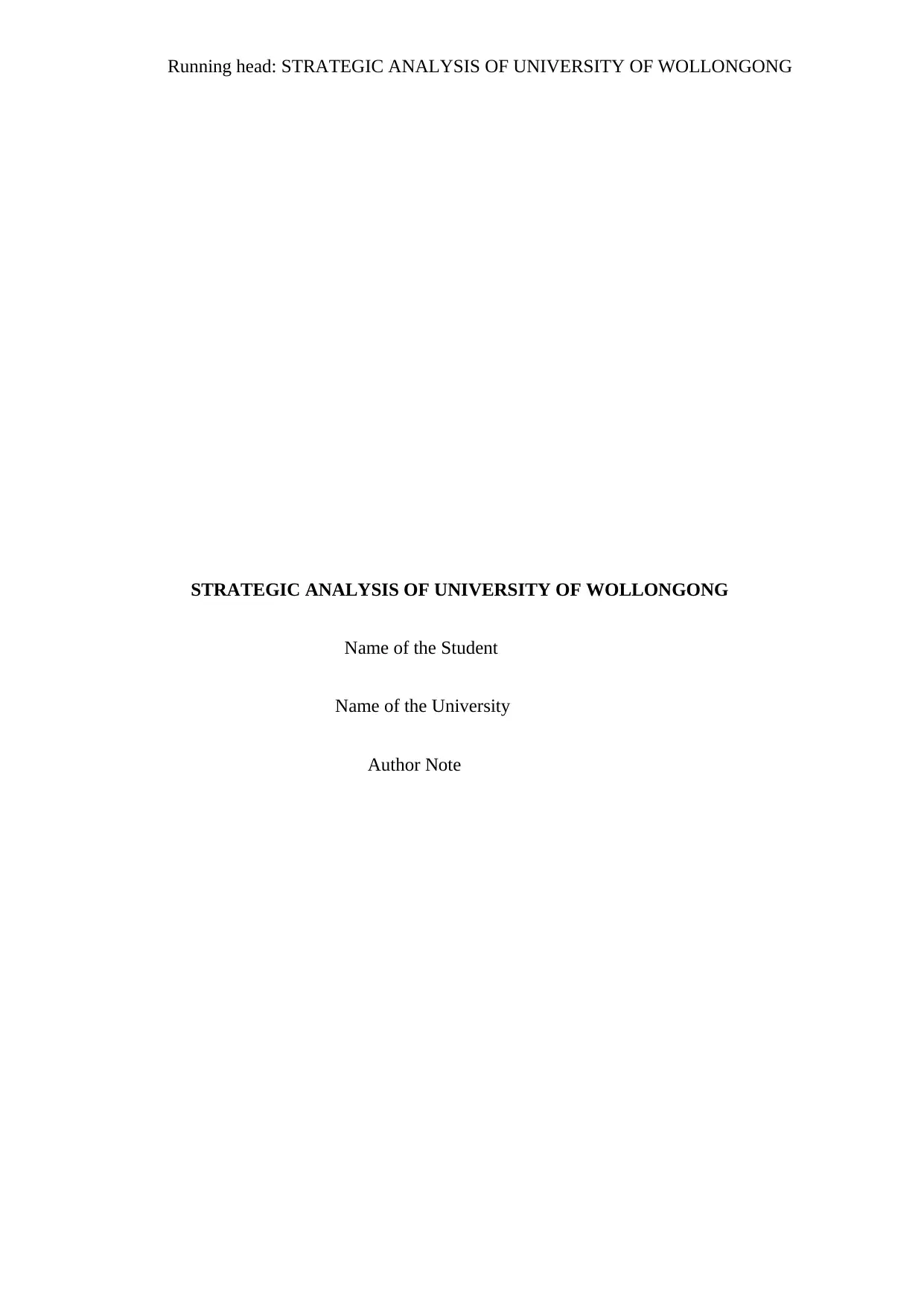
Running head: STRATEGIC ANALYSIS OF UNIVERSITY OF WOLLONGONG
STRATEGIC ANALYSIS OF UNIVERSITY OF WOLLONGONG
Name of the Student
Name of the University
Author Note
STRATEGIC ANALYSIS OF UNIVERSITY OF WOLLONGONG
Name of the Student
Name of the University
Author Note
Paraphrase This Document
Need a fresh take? Get an instant paraphrase of this document with our AI Paraphraser
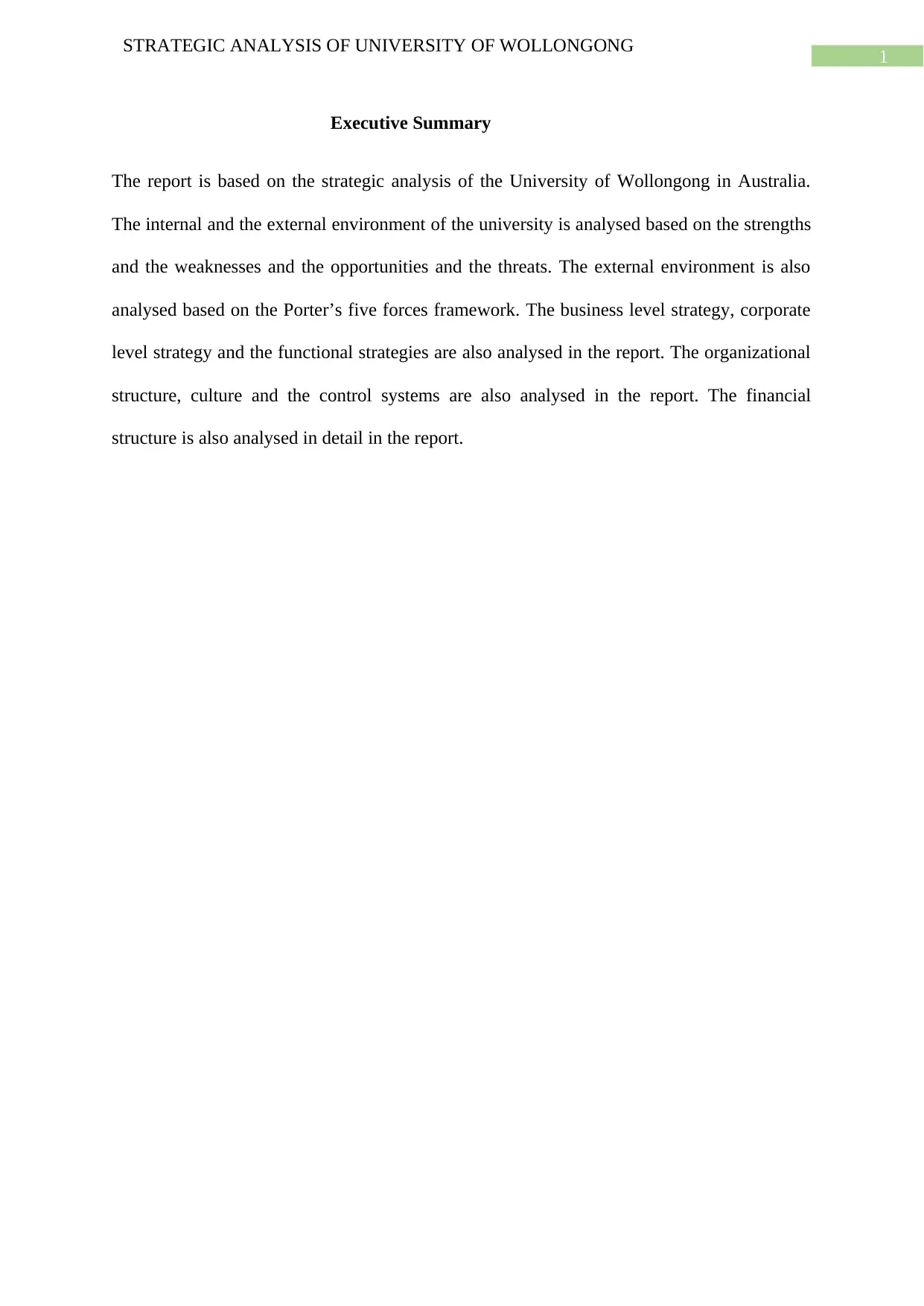
1
STRATEGIC ANALYSIS OF UNIVERSITY OF WOLLONGONG
Executive Summary
The report is based on the strategic analysis of the University of Wollongong in Australia.
The internal and the external environment of the university is analysed based on the strengths
and the weaknesses and the opportunities and the threats. The external environment is also
analysed based on the Porter’s five forces framework. The business level strategy, corporate
level strategy and the functional strategies are also analysed in the report. The organizational
structure, culture and the control systems are also analysed in the report. The financial
structure is also analysed in detail in the report.
STRATEGIC ANALYSIS OF UNIVERSITY OF WOLLONGONG
Executive Summary
The report is based on the strategic analysis of the University of Wollongong in Australia.
The internal and the external environment of the university is analysed based on the strengths
and the weaknesses and the opportunities and the threats. The external environment is also
analysed based on the Porter’s five forces framework. The business level strategy, corporate
level strategy and the functional strategies are also analysed in the report. The organizational
structure, culture and the control systems are also analysed in the report. The financial
structure is also analysed in detail in the report.
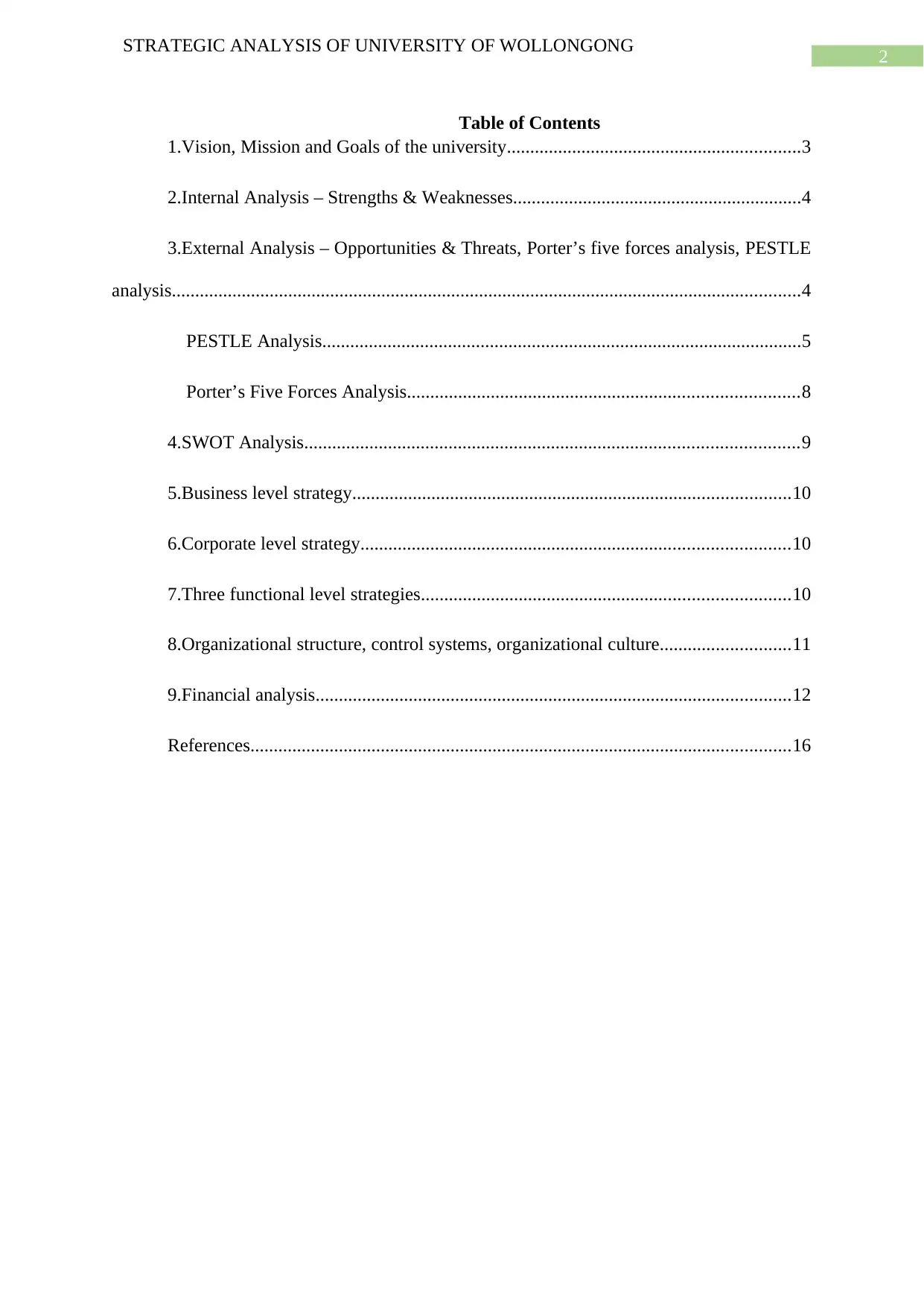
2
STRATEGIC ANALYSIS OF UNIVERSITY OF WOLLONGONG
Table of Contents
1.Vision, Mission and Goals of the university...............................................................3
2.Internal Analysis – Strengths & Weaknesses..............................................................4
3.External Analysis – Opportunities & Threats, Porter’s five forces analysis, PESTLE
analysis.......................................................................................................................................4
PESTLE Analysis.......................................................................................................5
Porter’s Five Forces Analysis....................................................................................8
4.SWOT Analysis..........................................................................................................9
5.Business level strategy..............................................................................................10
6.Corporate level strategy............................................................................................10
7.Three functional level strategies...............................................................................10
8.Organizational structure, control systems, organizational culture............................11
9.Financial analysis......................................................................................................12
References....................................................................................................................16
STRATEGIC ANALYSIS OF UNIVERSITY OF WOLLONGONG
Table of Contents
1.Vision, Mission and Goals of the university...............................................................3
2.Internal Analysis – Strengths & Weaknesses..............................................................4
3.External Analysis – Opportunities & Threats, Porter’s five forces analysis, PESTLE
analysis.......................................................................................................................................4
PESTLE Analysis.......................................................................................................5
Porter’s Five Forces Analysis....................................................................................8
4.SWOT Analysis..........................................................................................................9
5.Business level strategy..............................................................................................10
6.Corporate level strategy............................................................................................10
7.Three functional level strategies...............................................................................10
8.Organizational structure, control systems, organizational culture............................11
9.Financial analysis......................................................................................................12
References....................................................................................................................16
⊘ This is a preview!⊘
Do you want full access?
Subscribe today to unlock all pages.

Trusted by 1+ million students worldwide
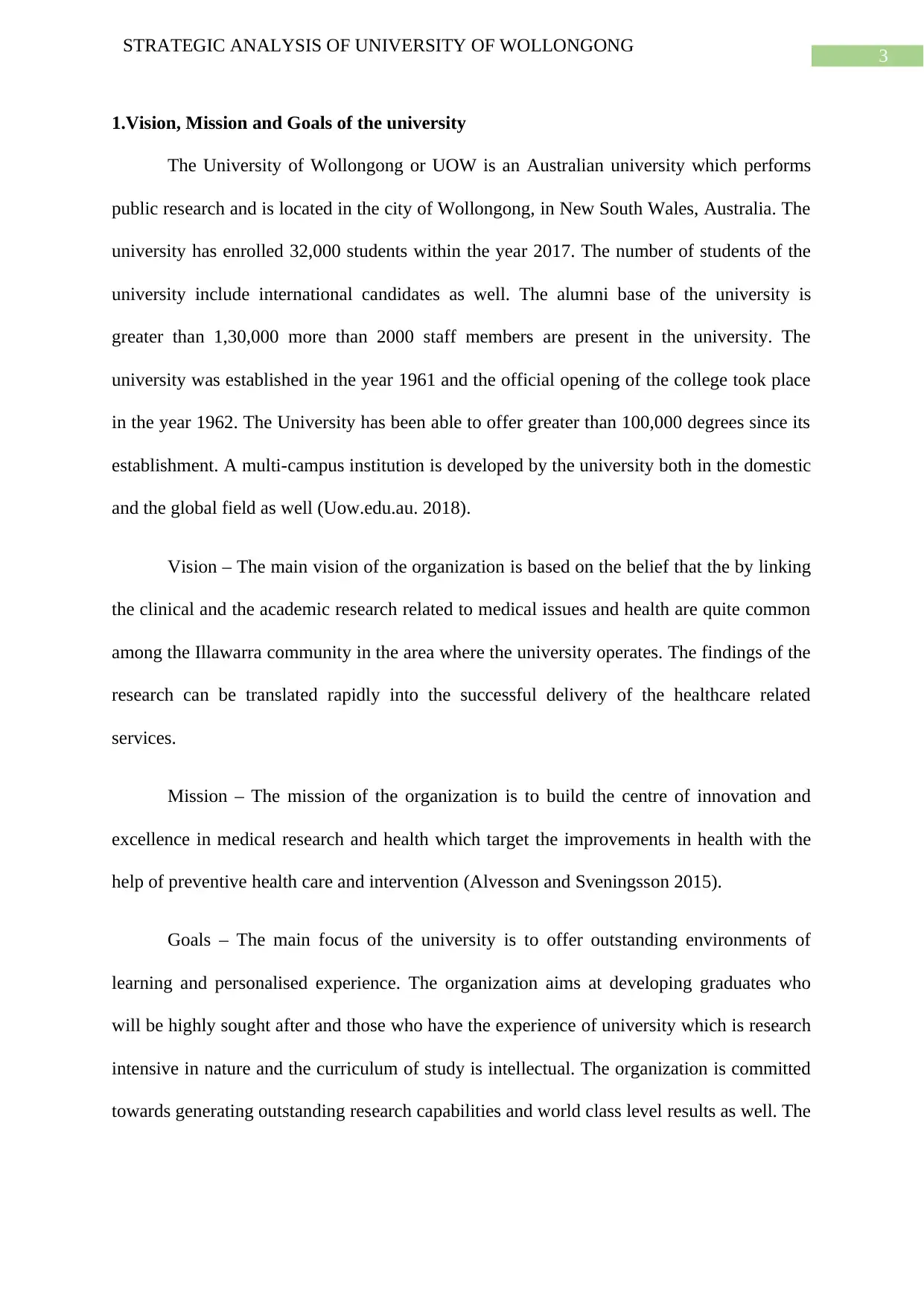
3
STRATEGIC ANALYSIS OF UNIVERSITY OF WOLLONGONG
1.Vision, Mission and Goals of the university
The University of Wollongong or UOW is an Australian university which performs
public research and is located in the city of Wollongong, in New South Wales, Australia. The
university has enrolled 32,000 students within the year 2017. The number of students of the
university include international candidates as well. The alumni base of the university is
greater than 1,30,000 more than 2000 staff members are present in the university. The
university was established in the year 1961 and the official opening of the college took place
in the year 1962. The University has been able to offer greater than 100,000 degrees since its
establishment. A multi-campus institution is developed by the university both in the domestic
and the global field as well (Uow.edu.au. 2018).
Vision – The main vision of the organization is based on the belief that the by linking
the clinical and the academic research related to medical issues and health are quite common
among the Illawarra community in the area where the university operates. The findings of the
research can be translated rapidly into the successful delivery of the healthcare related
services.
Mission – The mission of the organization is to build the centre of innovation and
excellence in medical research and health which target the improvements in health with the
help of preventive health care and intervention (Alvesson and Sveningsson 2015).
Goals – The main focus of the university is to offer outstanding environments of
learning and personalised experience. The organization aims at developing graduates who
will be highly sought after and those who have the experience of university which is research
intensive in nature and the curriculum of study is intellectual. The organization is committed
towards generating outstanding research capabilities and world class level results as well. The
STRATEGIC ANALYSIS OF UNIVERSITY OF WOLLONGONG
1.Vision, Mission and Goals of the university
The University of Wollongong or UOW is an Australian university which performs
public research and is located in the city of Wollongong, in New South Wales, Australia. The
university has enrolled 32,000 students within the year 2017. The number of students of the
university include international candidates as well. The alumni base of the university is
greater than 1,30,000 more than 2000 staff members are present in the university. The
university was established in the year 1961 and the official opening of the college took place
in the year 1962. The University has been able to offer greater than 100,000 degrees since its
establishment. A multi-campus institution is developed by the university both in the domestic
and the global field as well (Uow.edu.au. 2018).
Vision – The main vision of the organization is based on the belief that the by linking
the clinical and the academic research related to medical issues and health are quite common
among the Illawarra community in the area where the university operates. The findings of the
research can be translated rapidly into the successful delivery of the healthcare related
services.
Mission – The mission of the organization is to build the centre of innovation and
excellence in medical research and health which target the improvements in health with the
help of preventive health care and intervention (Alvesson and Sveningsson 2015).
Goals – The main focus of the university is to offer outstanding environments of
learning and personalised experience. The organization aims at developing graduates who
will be highly sought after and those who have the experience of university which is research
intensive in nature and the curriculum of study is intellectual. The organization is committed
towards generating outstanding research capabilities and world class level results as well. The
Paraphrase This Document
Need a fresh take? Get an instant paraphrase of this document with our AI Paraphraser
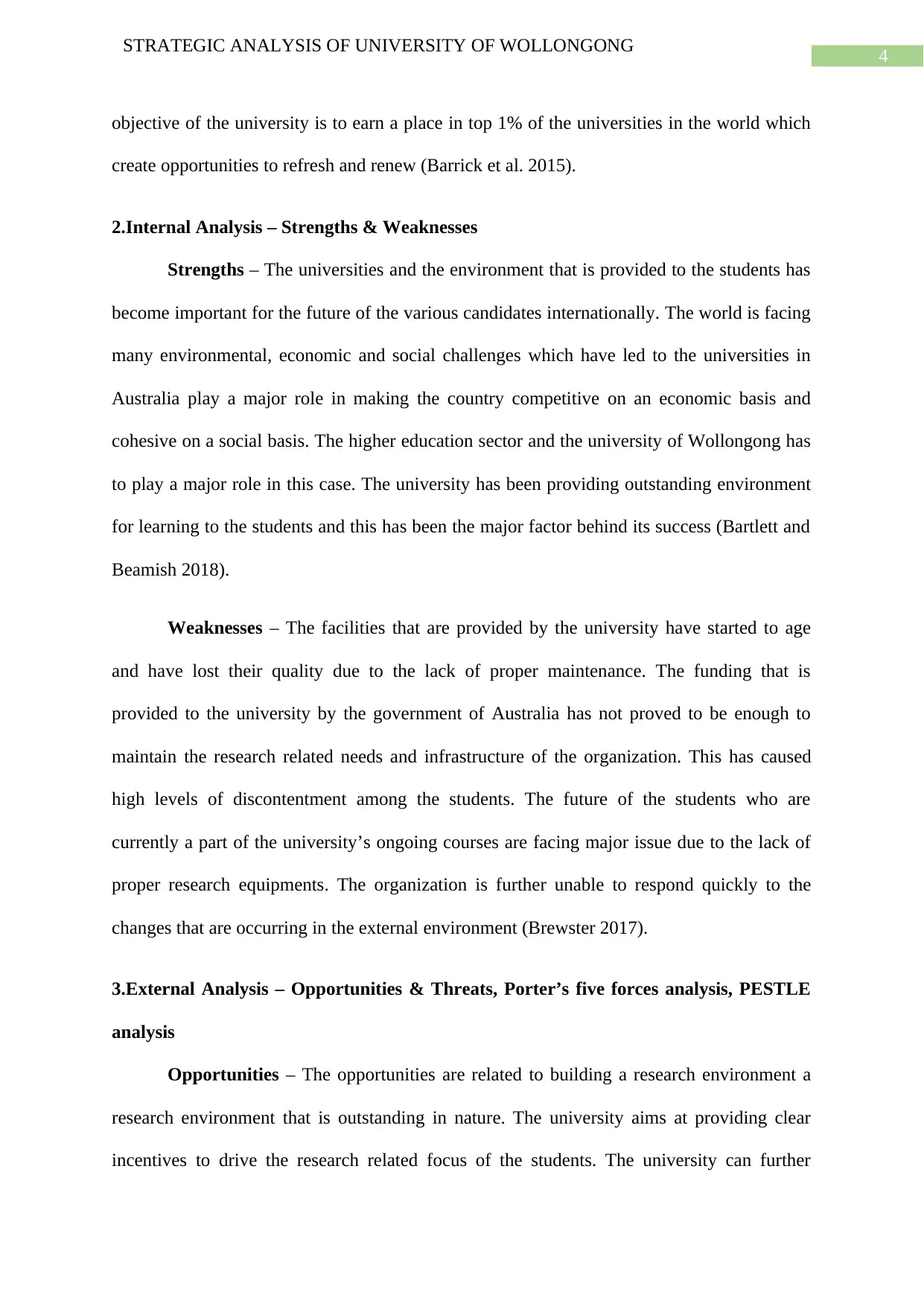
4
STRATEGIC ANALYSIS OF UNIVERSITY OF WOLLONGONG
objective of the university is to earn a place in top 1% of the universities in the world which
create opportunities to refresh and renew (Barrick et al. 2015).
2.Internal Analysis – Strengths & Weaknesses
Strengths – The universities and the environment that is provided to the students has
become important for the future of the various candidates internationally. The world is facing
many environmental, economic and social challenges which have led to the universities in
Australia play a major role in making the country competitive on an economic basis and
cohesive on a social basis. The higher education sector and the university of Wollongong has
to play a major role in this case. The university has been providing outstanding environment
for learning to the students and this has been the major factor behind its success (Bartlett and
Beamish 2018).
Weaknesses – The facilities that are provided by the university have started to age
and have lost their quality due to the lack of proper maintenance. The funding that is
provided to the university by the government of Australia has not proved to be enough to
maintain the research related needs and infrastructure of the organization. This has caused
high levels of discontentment among the students. The future of the students who are
currently a part of the university’s ongoing courses are facing major issue due to the lack of
proper research equipments. The organization is further unable to respond quickly to the
changes that are occurring in the external environment (Brewster 2017).
3.External Analysis – Opportunities & Threats, Porter’s five forces analysis, PESTLE
analysis
Opportunities – The opportunities are related to building a research environment a
research environment that is outstanding in nature. The university aims at providing clear
incentives to drive the research related focus of the students. The university can further
STRATEGIC ANALYSIS OF UNIVERSITY OF WOLLONGONG
objective of the university is to earn a place in top 1% of the universities in the world which
create opportunities to refresh and renew (Barrick et al. 2015).
2.Internal Analysis – Strengths & Weaknesses
Strengths – The universities and the environment that is provided to the students has
become important for the future of the various candidates internationally. The world is facing
many environmental, economic and social challenges which have led to the universities in
Australia play a major role in making the country competitive on an economic basis and
cohesive on a social basis. The higher education sector and the university of Wollongong has
to play a major role in this case. The university has been providing outstanding environment
for learning to the students and this has been the major factor behind its success (Bartlett and
Beamish 2018).
Weaknesses – The facilities that are provided by the university have started to age
and have lost their quality due to the lack of proper maintenance. The funding that is
provided to the university by the government of Australia has not proved to be enough to
maintain the research related needs and infrastructure of the organization. This has caused
high levels of discontentment among the students. The future of the students who are
currently a part of the university’s ongoing courses are facing major issue due to the lack of
proper research equipments. The organization is further unable to respond quickly to the
changes that are occurring in the external environment (Brewster 2017).
3.External Analysis – Opportunities & Threats, Porter’s five forces analysis, PESTLE
analysis
Opportunities – The opportunities are related to building a research environment a
research environment that is outstanding in nature. The university aims at providing clear
incentives to drive the research related focus of the students. The university can further
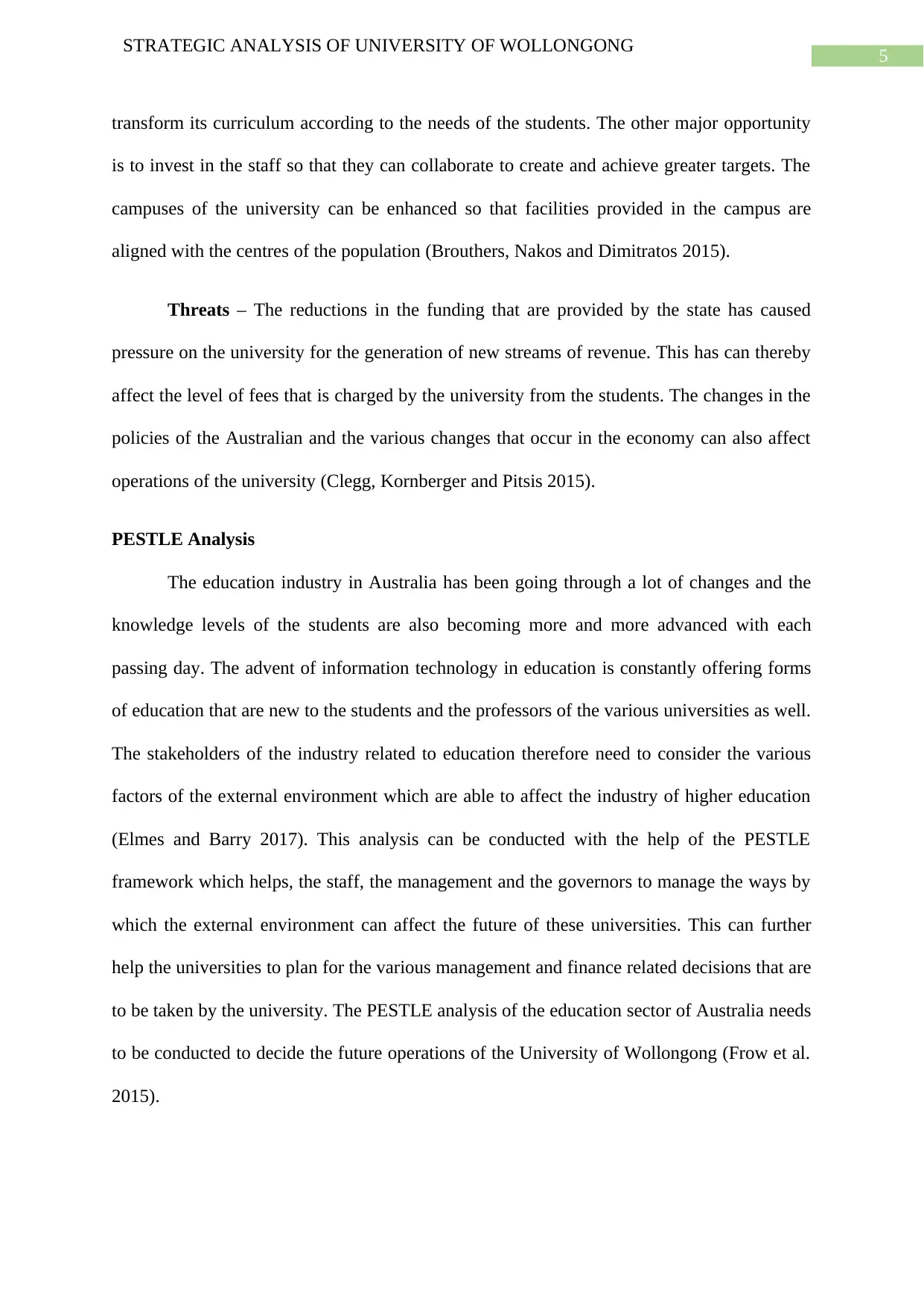
5
STRATEGIC ANALYSIS OF UNIVERSITY OF WOLLONGONG
transform its curriculum according to the needs of the students. The other major opportunity
is to invest in the staff so that they can collaborate to create and achieve greater targets. The
campuses of the university can be enhanced so that facilities provided in the campus are
aligned with the centres of the population (Brouthers, Nakos and Dimitratos 2015).
Threats – The reductions in the funding that are provided by the state has caused
pressure on the university for the generation of new streams of revenue. This has can thereby
affect the level of fees that is charged by the university from the students. The changes in the
policies of the Australian and the various changes that occur in the economy can also affect
operations of the university (Clegg, Kornberger and Pitsis 2015).
PESTLE Analysis
The education industry in Australia has been going through a lot of changes and the
knowledge levels of the students are also becoming more and more advanced with each
passing day. The advent of information technology in education is constantly offering forms
of education that are new to the students and the professors of the various universities as well.
The stakeholders of the industry related to education therefore need to consider the various
factors of the external environment which are able to affect the industry of higher education
(Elmes and Barry 2017). This analysis can be conducted with the help of the PESTLE
framework which helps, the staff, the management and the governors to manage the ways by
which the external environment can affect the future of these universities. This can further
help the universities to plan for the various management and finance related decisions that are
to be taken by the university. The PESTLE analysis of the education sector of Australia needs
to be conducted to decide the future operations of the University of Wollongong (Frow et al.
2015).
STRATEGIC ANALYSIS OF UNIVERSITY OF WOLLONGONG
transform its curriculum according to the needs of the students. The other major opportunity
is to invest in the staff so that they can collaborate to create and achieve greater targets. The
campuses of the university can be enhanced so that facilities provided in the campus are
aligned with the centres of the population (Brouthers, Nakos and Dimitratos 2015).
Threats – The reductions in the funding that are provided by the state has caused
pressure on the university for the generation of new streams of revenue. This has can thereby
affect the level of fees that is charged by the university from the students. The changes in the
policies of the Australian and the various changes that occur in the economy can also affect
operations of the university (Clegg, Kornberger and Pitsis 2015).
PESTLE Analysis
The education industry in Australia has been going through a lot of changes and the
knowledge levels of the students are also becoming more and more advanced with each
passing day. The advent of information technology in education is constantly offering forms
of education that are new to the students and the professors of the various universities as well.
The stakeholders of the industry related to education therefore need to consider the various
factors of the external environment which are able to affect the industry of higher education
(Elmes and Barry 2017). This analysis can be conducted with the help of the PESTLE
framework which helps, the staff, the management and the governors to manage the ways by
which the external environment can affect the future of these universities. This can further
help the universities to plan for the various management and finance related decisions that are
to be taken by the university. The PESTLE analysis of the education sector of Australia needs
to be conducted to decide the future operations of the University of Wollongong (Frow et al.
2015).
⊘ This is a preview!⊘
Do you want full access?
Subscribe today to unlock all pages.

Trusted by 1+ million students worldwide
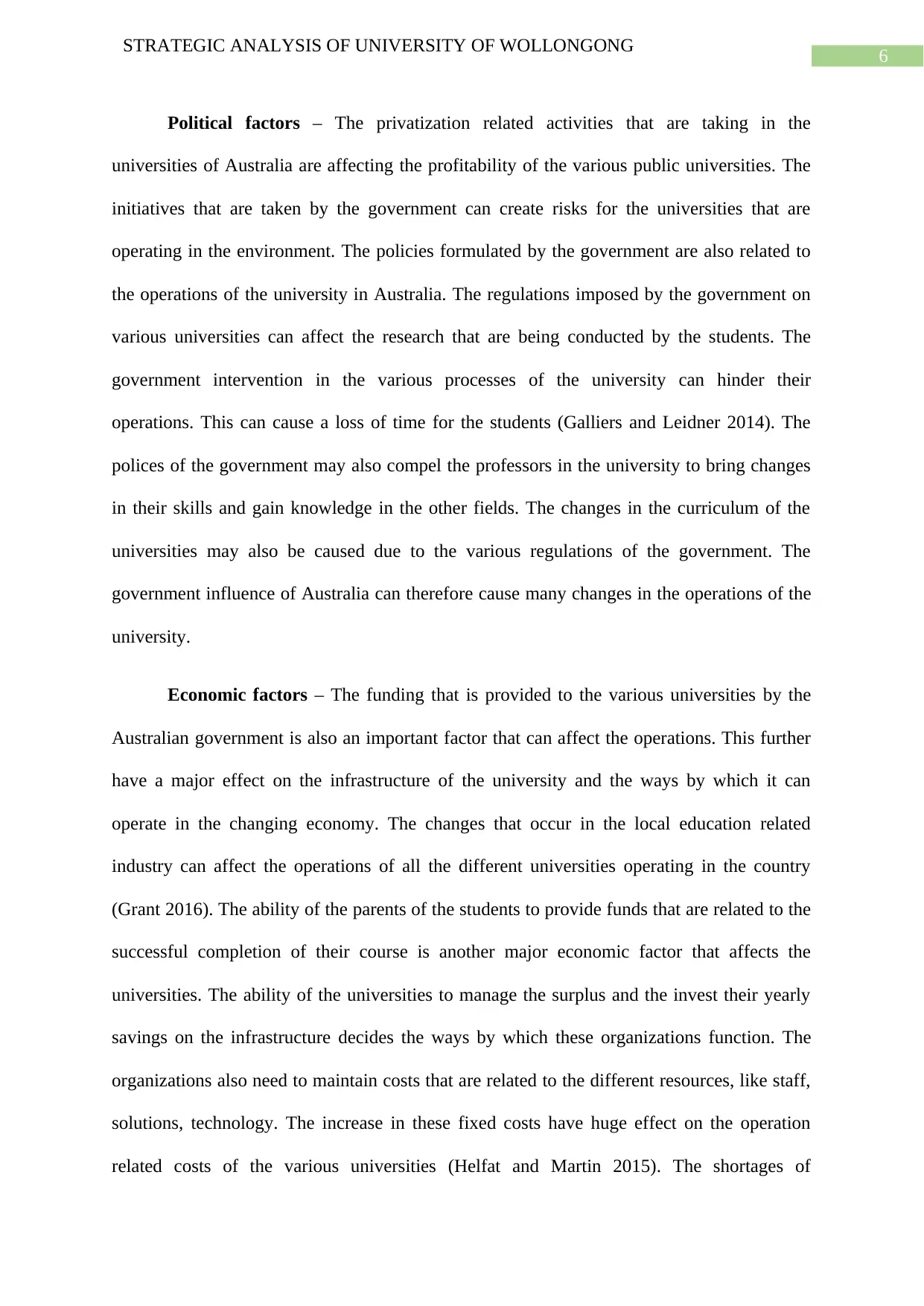
6
STRATEGIC ANALYSIS OF UNIVERSITY OF WOLLONGONG
Political factors – The privatization related activities that are taking in the
universities of Australia are affecting the profitability of the various public universities. The
initiatives that are taken by the government can create risks for the universities that are
operating in the environment. The policies formulated by the government are also related to
the operations of the university in Australia. The regulations imposed by the government on
various universities can affect the research that are being conducted by the students. The
government intervention in the various processes of the university can hinder their
operations. This can cause a loss of time for the students (Galliers and Leidner 2014). The
polices of the government may also compel the professors in the university to bring changes
in their skills and gain knowledge in the other fields. The changes in the curriculum of the
universities may also be caused due to the various regulations of the government. The
government influence of Australia can therefore cause many changes in the operations of the
university.
Economic factors – The funding that is provided to the various universities by the
Australian government is also an important factor that can affect the operations. This further
have a major effect on the infrastructure of the university and the ways by which it can
operate in the changing economy. The changes that occur in the local education related
industry can affect the operations of all the different universities operating in the country
(Grant 2016). The ability of the parents of the students to provide funds that are related to the
successful completion of their course is another major economic factor that affects the
universities. The ability of the universities to manage the surplus and the invest their yearly
savings on the infrastructure decides the ways by which these organizations function. The
organizations also need to maintain costs that are related to the different resources, like staff,
solutions, technology. The increase in these fixed costs have huge effect on the operation
related costs of the various universities (Helfat and Martin 2015). The shortages of
STRATEGIC ANALYSIS OF UNIVERSITY OF WOLLONGONG
Political factors – The privatization related activities that are taking in the
universities of Australia are affecting the profitability of the various public universities. The
initiatives that are taken by the government can create risks for the universities that are
operating in the environment. The policies formulated by the government are also related to
the operations of the university in Australia. The regulations imposed by the government on
various universities can affect the research that are being conducted by the students. The
government intervention in the various processes of the university can hinder their
operations. This can cause a loss of time for the students (Galliers and Leidner 2014). The
polices of the government may also compel the professors in the university to bring changes
in their skills and gain knowledge in the other fields. The changes in the curriculum of the
universities may also be caused due to the various regulations of the government. The
government influence of Australia can therefore cause many changes in the operations of the
university.
Economic factors – The funding that is provided to the various universities by the
Australian government is also an important factor that can affect the operations. This further
have a major effect on the infrastructure of the university and the ways by which it can
operate in the changing economy. The changes that occur in the local education related
industry can affect the operations of all the different universities operating in the country
(Grant 2016). The ability of the parents of the students to provide funds that are related to the
successful completion of their course is another major economic factor that affects the
universities. The ability of the universities to manage the surplus and the invest their yearly
savings on the infrastructure decides the ways by which these organizations function. The
organizations also need to maintain costs that are related to the different resources, like staff,
solutions, technology. The increase in these fixed costs have huge effect on the operation
related costs of the various universities (Helfat and Martin 2015). The shortages of
Paraphrase This Document
Need a fresh take? Get an instant paraphrase of this document with our AI Paraphraser
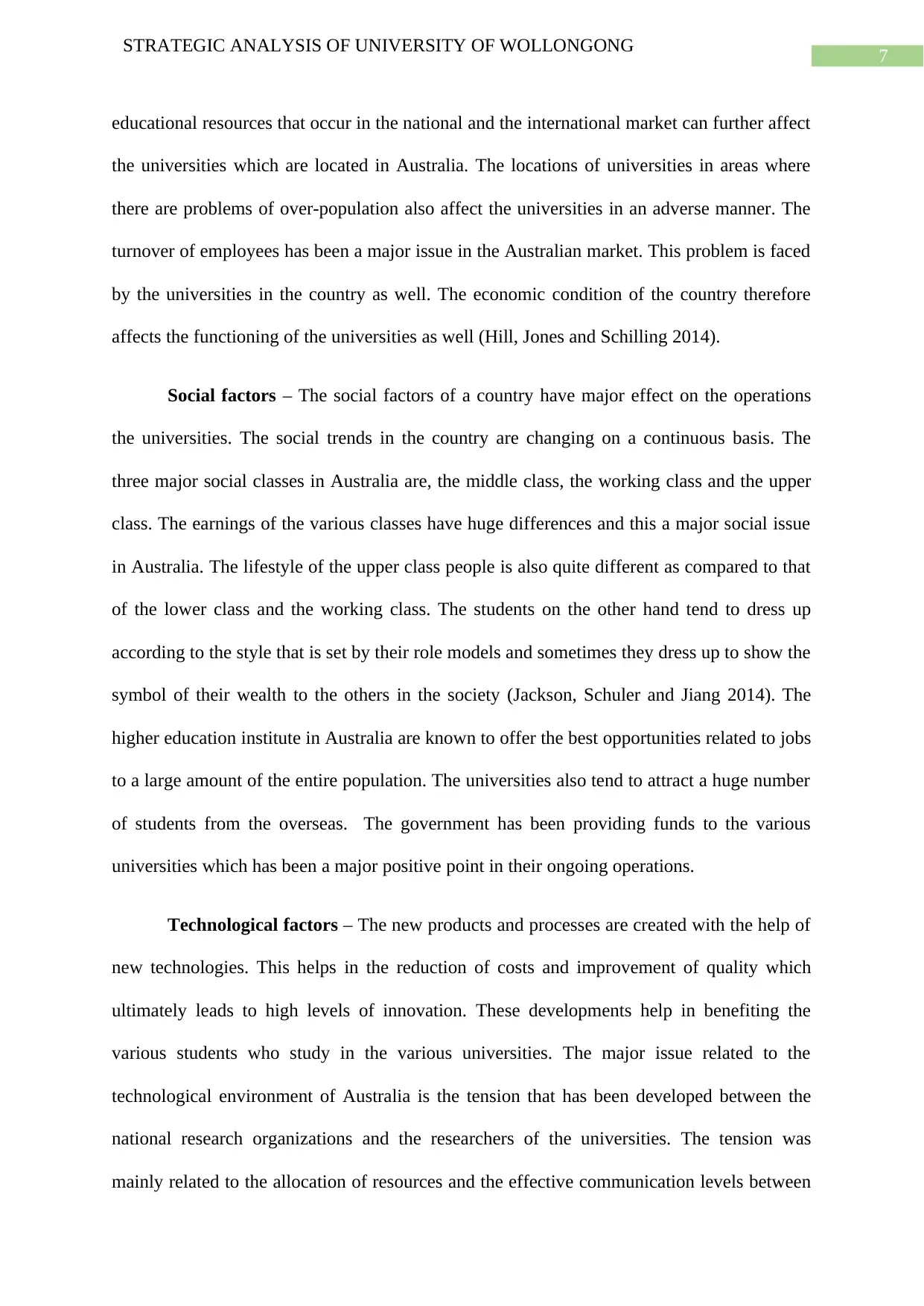
7
STRATEGIC ANALYSIS OF UNIVERSITY OF WOLLONGONG
educational resources that occur in the national and the international market can further affect
the universities which are located in Australia. The locations of universities in areas where
there are problems of over-population also affect the universities in an adverse manner. The
turnover of employees has been a major issue in the Australian market. This problem is faced
by the universities in the country as well. The economic condition of the country therefore
affects the functioning of the universities as well (Hill, Jones and Schilling 2014).
Social factors – The social factors of a country have major effect on the operations
the universities. The social trends in the country are changing on a continuous basis. The
three major social classes in Australia are, the middle class, the working class and the upper
class. The earnings of the various classes have huge differences and this a major social issue
in Australia. The lifestyle of the upper class people is also quite different as compared to that
of the lower class and the working class. The students on the other hand tend to dress up
according to the style that is set by their role models and sometimes they dress up to show the
symbol of their wealth to the others in the society (Jackson, Schuler and Jiang 2014). The
higher education institute in Australia are known to offer the best opportunities related to jobs
to a large amount of the entire population. The universities also tend to attract a huge number
of students from the overseas. The government has been providing funds to the various
universities which has been a major positive point in their ongoing operations.
Technological factors – The new products and processes are created with the help of
new technologies. This helps in the reduction of costs and improvement of quality which
ultimately leads to high levels of innovation. These developments help in benefiting the
various students who study in the various universities. The major issue related to the
technological environment of Australia is the tension that has been developed between the
national research organizations and the researchers of the universities. The tension was
mainly related to the allocation of resources and the effective communication levels between
STRATEGIC ANALYSIS OF UNIVERSITY OF WOLLONGONG
educational resources that occur in the national and the international market can further affect
the universities which are located in Australia. The locations of universities in areas where
there are problems of over-population also affect the universities in an adverse manner. The
turnover of employees has been a major issue in the Australian market. This problem is faced
by the universities in the country as well. The economic condition of the country therefore
affects the functioning of the universities as well (Hill, Jones and Schilling 2014).
Social factors – The social factors of a country have major effect on the operations
the universities. The social trends in the country are changing on a continuous basis. The
three major social classes in Australia are, the middle class, the working class and the upper
class. The earnings of the various classes have huge differences and this a major social issue
in Australia. The lifestyle of the upper class people is also quite different as compared to that
of the lower class and the working class. The students on the other hand tend to dress up
according to the style that is set by their role models and sometimes they dress up to show the
symbol of their wealth to the others in the society (Jackson, Schuler and Jiang 2014). The
higher education institute in Australia are known to offer the best opportunities related to jobs
to a large amount of the entire population. The universities also tend to attract a huge number
of students from the overseas. The government has been providing funds to the various
universities which has been a major positive point in their ongoing operations.
Technological factors – The new products and processes are created with the help of
new technologies. This helps in the reduction of costs and improvement of quality which
ultimately leads to high levels of innovation. These developments help in benefiting the
various students who study in the various universities. The major issue related to the
technological environment of Australia is the tension that has been developed between the
national research organizations and the researchers of the universities. The tension was
mainly related to the allocation of resources and the effective communication levels between
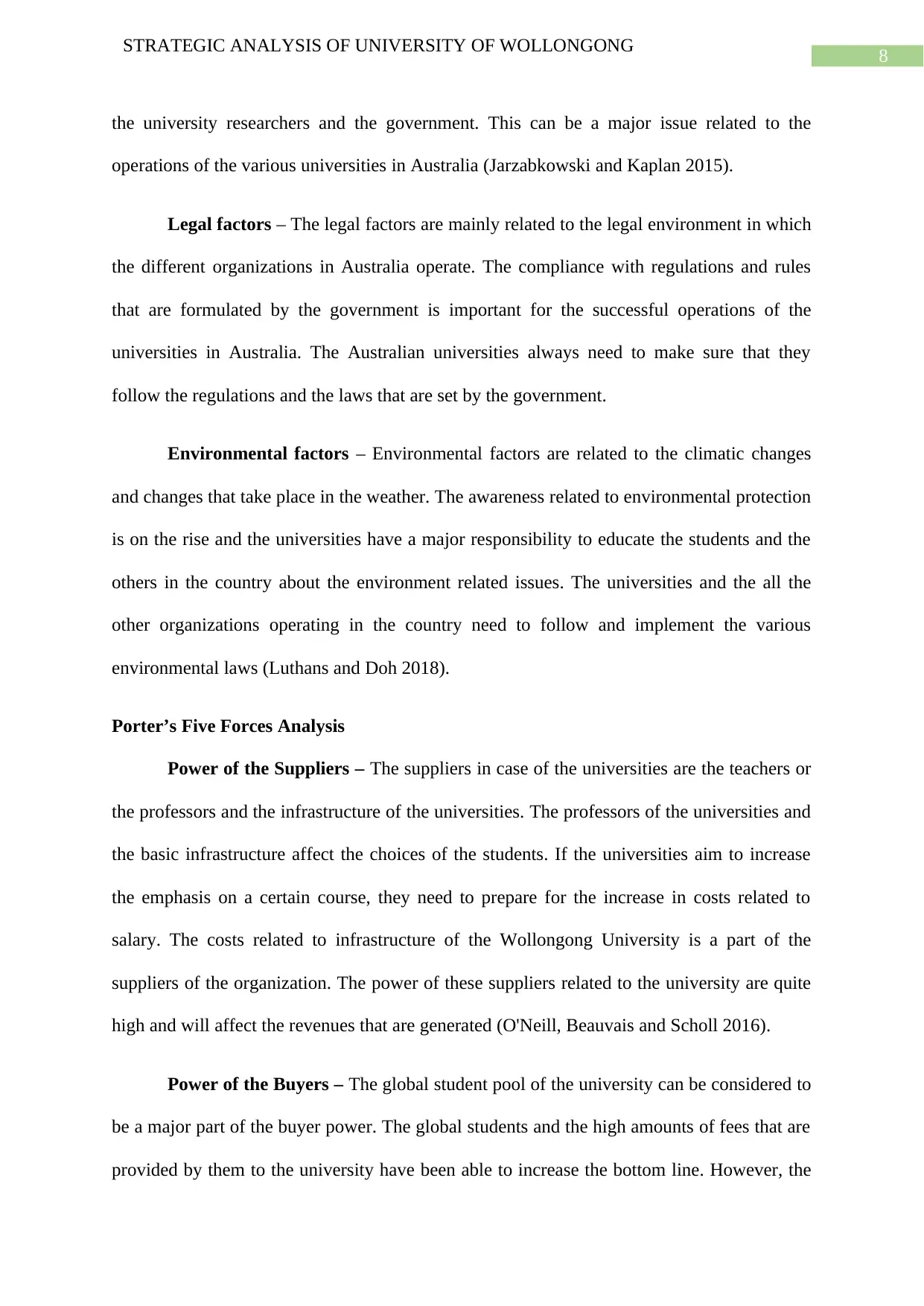
8
STRATEGIC ANALYSIS OF UNIVERSITY OF WOLLONGONG
the university researchers and the government. This can be a major issue related to the
operations of the various universities in Australia (Jarzabkowski and Kaplan 2015).
Legal factors – The legal factors are mainly related to the legal environment in which
the different organizations in Australia operate. The compliance with regulations and rules
that are formulated by the government is important for the successful operations of the
universities in Australia. The Australian universities always need to make sure that they
follow the regulations and the laws that are set by the government.
Environmental factors – Environmental factors are related to the climatic changes
and changes that take place in the weather. The awareness related to environmental protection
is on the rise and the universities have a major responsibility to educate the students and the
others in the country about the environment related issues. The universities and the all the
other organizations operating in the country need to follow and implement the various
environmental laws (Luthans and Doh 2018).
Porter’s Five Forces Analysis
Power of the Suppliers – The suppliers in case of the universities are the teachers or
the professors and the infrastructure of the universities. The professors of the universities and
the basic infrastructure affect the choices of the students. If the universities aim to increase
the emphasis on a certain course, they need to prepare for the increase in costs related to
salary. The costs related to infrastructure of the Wollongong University is a part of the
suppliers of the organization. The power of these suppliers related to the university are quite
high and will affect the revenues that are generated (O'Neill, Beauvais and Scholl 2016).
Power of the Buyers – The global student pool of the university can be considered to
be a major part of the buyer power. The global students and the high amounts of fees that are
provided by them to the university have been able to increase the bottom line. However, the
STRATEGIC ANALYSIS OF UNIVERSITY OF WOLLONGONG
the university researchers and the government. This can be a major issue related to the
operations of the various universities in Australia (Jarzabkowski and Kaplan 2015).
Legal factors – The legal factors are mainly related to the legal environment in which
the different organizations in Australia operate. The compliance with regulations and rules
that are formulated by the government is important for the successful operations of the
universities in Australia. The Australian universities always need to make sure that they
follow the regulations and the laws that are set by the government.
Environmental factors – Environmental factors are related to the climatic changes
and changes that take place in the weather. The awareness related to environmental protection
is on the rise and the universities have a major responsibility to educate the students and the
others in the country about the environment related issues. The universities and the all the
other organizations operating in the country need to follow and implement the various
environmental laws (Luthans and Doh 2018).
Porter’s Five Forces Analysis
Power of the Suppliers – The suppliers in case of the universities are the teachers or
the professors and the infrastructure of the universities. The professors of the universities and
the basic infrastructure affect the choices of the students. If the universities aim to increase
the emphasis on a certain course, they need to prepare for the increase in costs related to
salary. The costs related to infrastructure of the Wollongong University is a part of the
suppliers of the organization. The power of these suppliers related to the university are quite
high and will affect the revenues that are generated (O'Neill, Beauvais and Scholl 2016).
Power of the Buyers – The global student pool of the university can be considered to
be a major part of the buyer power. The global students and the high amounts of fees that are
provided by them to the university have been able to increase the bottom line. However, the
⊘ This is a preview!⊘
Do you want full access?
Subscribe today to unlock all pages.

Trusted by 1+ million students worldwide
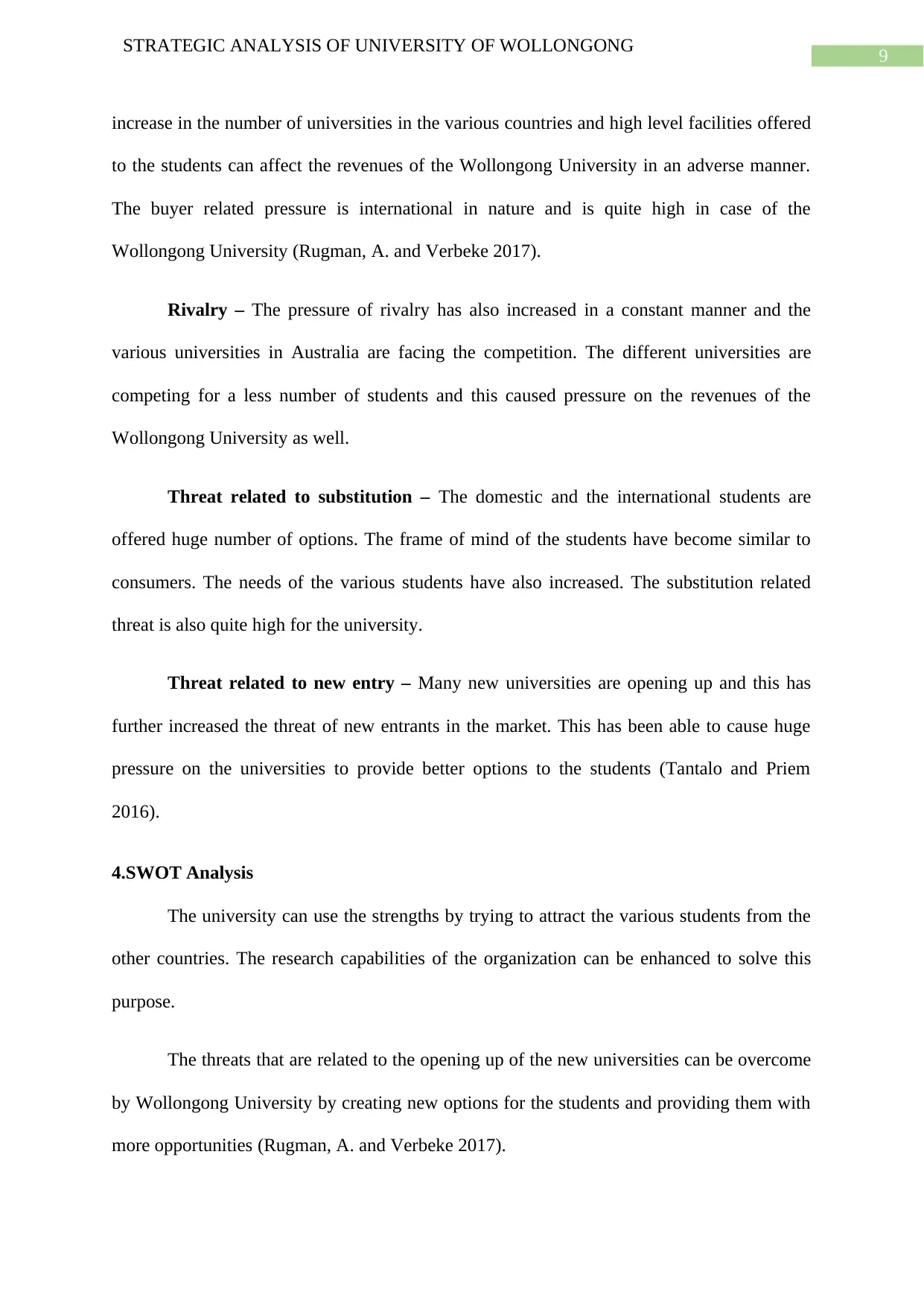
9
STRATEGIC ANALYSIS OF UNIVERSITY OF WOLLONGONG
increase in the number of universities in the various countries and high level facilities offered
to the students can affect the revenues of the Wollongong University in an adverse manner.
The buyer related pressure is international in nature and is quite high in case of the
Wollongong University (Rugman, A. and Verbeke 2017).
Rivalry – The pressure of rivalry has also increased in a constant manner and the
various universities in Australia are facing the competition. The different universities are
competing for a less number of students and this caused pressure on the revenues of the
Wollongong University as well.
Threat related to substitution – The domestic and the international students are
offered huge number of options. The frame of mind of the students have become similar to
consumers. The needs of the various students have also increased. The substitution related
threat is also quite high for the university.
Threat related to new entry – Many new universities are opening up and this has
further increased the threat of new entrants in the market. This has been able to cause huge
pressure on the universities to provide better options to the students (Tantalo and Priem
2016).
4.SWOT Analysis
The university can use the strengths by trying to attract the various students from the
other countries. The research capabilities of the organization can be enhanced to solve this
purpose.
The threats that are related to the opening up of the new universities can be overcome
by Wollongong University by creating new options for the students and providing them with
more opportunities (Rugman, A. and Verbeke 2017).
STRATEGIC ANALYSIS OF UNIVERSITY OF WOLLONGONG
increase in the number of universities in the various countries and high level facilities offered
to the students can affect the revenues of the Wollongong University in an adverse manner.
The buyer related pressure is international in nature and is quite high in case of the
Wollongong University (Rugman, A. and Verbeke 2017).
Rivalry – The pressure of rivalry has also increased in a constant manner and the
various universities in Australia are facing the competition. The different universities are
competing for a less number of students and this caused pressure on the revenues of the
Wollongong University as well.
Threat related to substitution – The domestic and the international students are
offered huge number of options. The frame of mind of the students have become similar to
consumers. The needs of the various students have also increased. The substitution related
threat is also quite high for the university.
Threat related to new entry – Many new universities are opening up and this has
further increased the threat of new entrants in the market. This has been able to cause huge
pressure on the universities to provide better options to the students (Tantalo and Priem
2016).
4.SWOT Analysis
The university can use the strengths by trying to attract the various students from the
other countries. The research capabilities of the organization can be enhanced to solve this
purpose.
The threats that are related to the opening up of the new universities can be overcome
by Wollongong University by creating new options for the students and providing them with
more opportunities (Rugman, A. and Verbeke 2017).
Paraphrase This Document
Need a fresh take? Get an instant paraphrase of this document with our AI Paraphraser
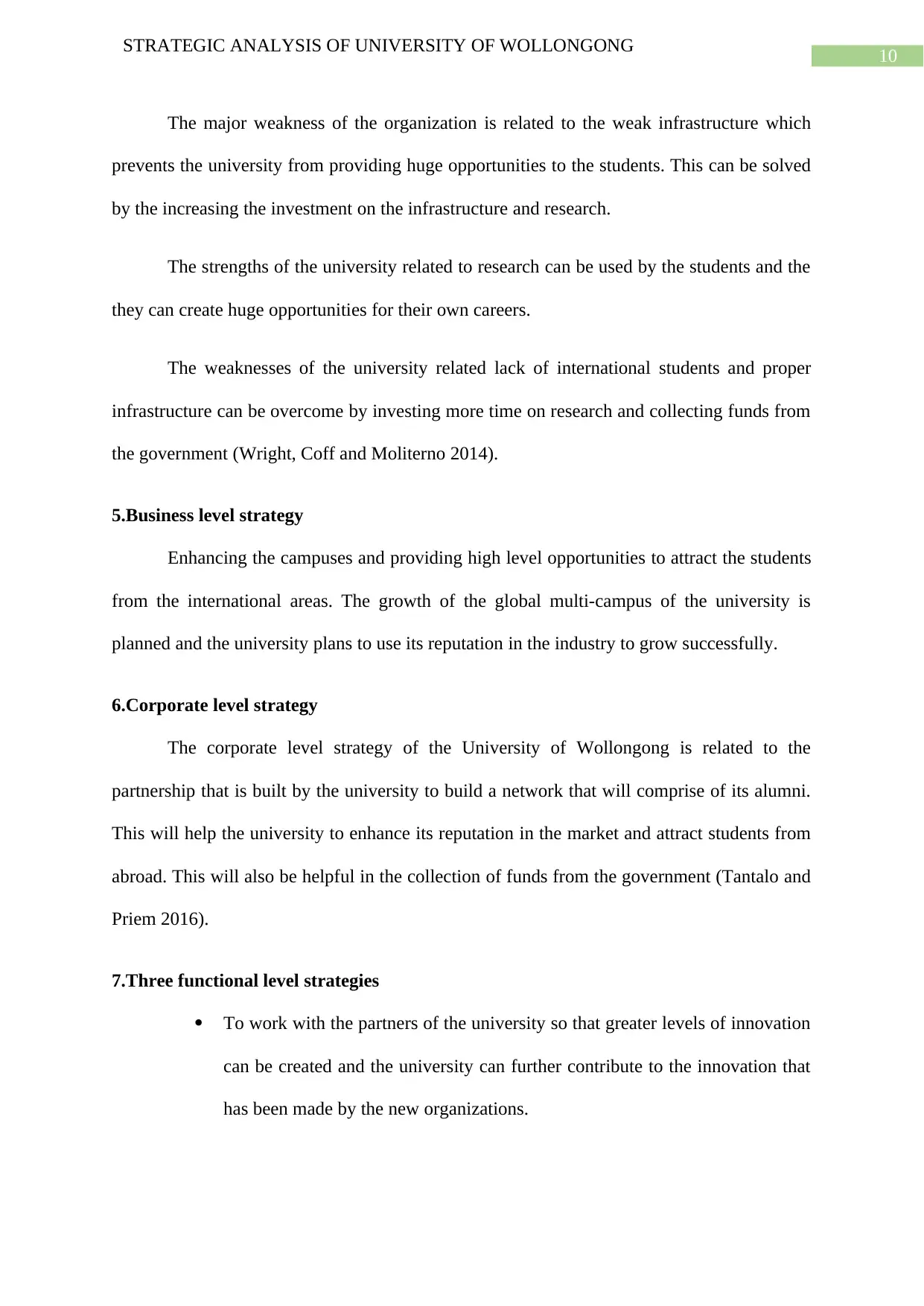
10
STRATEGIC ANALYSIS OF UNIVERSITY OF WOLLONGONG
The major weakness of the organization is related to the weak infrastructure which
prevents the university from providing huge opportunities to the students. This can be solved
by the increasing the investment on the infrastructure and research.
The strengths of the university related to research can be used by the students and the
they can create huge opportunities for their own careers.
The weaknesses of the university related lack of international students and proper
infrastructure can be overcome by investing more time on research and collecting funds from
the government (Wright, Coff and Moliterno 2014).
5.Business level strategy
Enhancing the campuses and providing high level opportunities to attract the students
from the international areas. The growth of the global multi-campus of the university is
planned and the university plans to use its reputation in the industry to grow successfully.
6.Corporate level strategy
The corporate level strategy of the University of Wollongong is related to the
partnership that is built by the university to build a network that will comprise of its alumni.
This will help the university to enhance its reputation in the market and attract students from
abroad. This will also be helpful in the collection of funds from the government (Tantalo and
Priem 2016).
7.Three functional level strategies
To work with the partners of the university so that greater levels of innovation
can be created and the university can further contribute to the innovation that
has been made by the new organizations.
STRATEGIC ANALYSIS OF UNIVERSITY OF WOLLONGONG
The major weakness of the organization is related to the weak infrastructure which
prevents the university from providing huge opportunities to the students. This can be solved
by the increasing the investment on the infrastructure and research.
The strengths of the university related to research can be used by the students and the
they can create huge opportunities for their own careers.
The weaknesses of the university related lack of international students and proper
infrastructure can be overcome by investing more time on research and collecting funds from
the government (Wright, Coff and Moliterno 2014).
5.Business level strategy
Enhancing the campuses and providing high level opportunities to attract the students
from the international areas. The growth of the global multi-campus of the university is
planned and the university plans to use its reputation in the industry to grow successfully.
6.Corporate level strategy
The corporate level strategy of the University of Wollongong is related to the
partnership that is built by the university to build a network that will comprise of its alumni.
This will help the university to enhance its reputation in the market and attract students from
abroad. This will also be helpful in the collection of funds from the government (Tantalo and
Priem 2016).
7.Three functional level strategies
To work with the partners of the university so that greater levels of innovation
can be created and the university can further contribute to the innovation that
has been made by the new organizations.
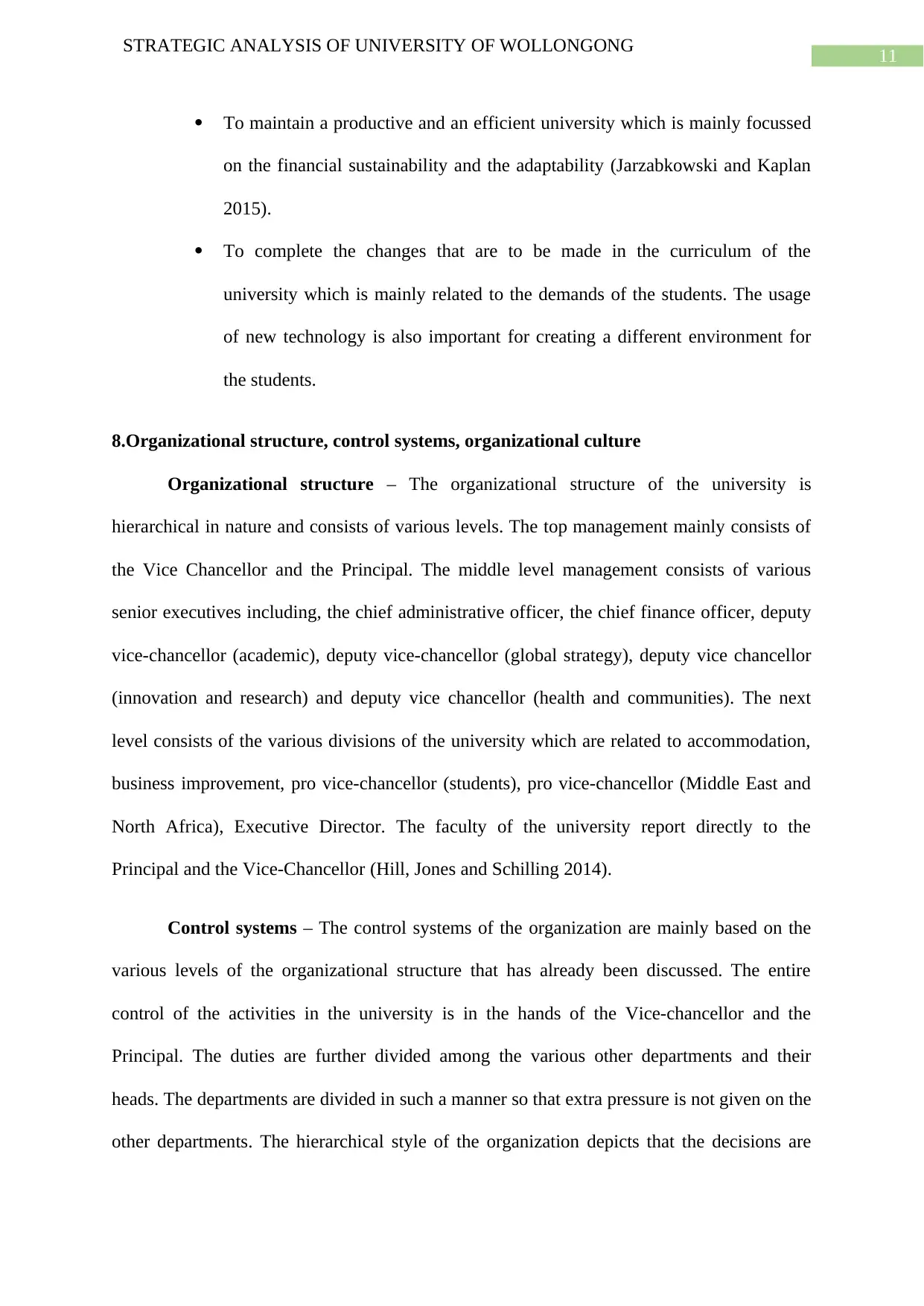
11
STRATEGIC ANALYSIS OF UNIVERSITY OF WOLLONGONG
To maintain a productive and an efficient university which is mainly focussed
on the financial sustainability and the adaptability (Jarzabkowski and Kaplan
2015).
To complete the changes that are to be made in the curriculum of the
university which is mainly related to the demands of the students. The usage
of new technology is also important for creating a different environment for
the students.
8.Organizational structure, control systems, organizational culture
Organizational structure – The organizational structure of the university is
hierarchical in nature and consists of various levels. The top management mainly consists of
the Vice Chancellor and the Principal. The middle level management consists of various
senior executives including, the chief administrative officer, the chief finance officer, deputy
vice-chancellor (academic), deputy vice-chancellor (global strategy), deputy vice chancellor
(innovation and research) and deputy vice chancellor (health and communities). The next
level consists of the various divisions of the university which are related to accommodation,
business improvement, pro vice-chancellor (students), pro vice-chancellor (Middle East and
North Africa), Executive Director. The faculty of the university report directly to the
Principal and the Vice-Chancellor (Hill, Jones and Schilling 2014).
Control systems – The control systems of the organization are mainly based on the
various levels of the organizational structure that has already been discussed. The entire
control of the activities in the university is in the hands of the Vice-chancellor and the
Principal. The duties are further divided among the various other departments and their
heads. The departments are divided in such a manner so that extra pressure is not given on the
other departments. The hierarchical style of the organization depicts that the decisions are
STRATEGIC ANALYSIS OF UNIVERSITY OF WOLLONGONG
To maintain a productive and an efficient university which is mainly focussed
on the financial sustainability and the adaptability (Jarzabkowski and Kaplan
2015).
To complete the changes that are to be made in the curriculum of the
university which is mainly related to the demands of the students. The usage
of new technology is also important for creating a different environment for
the students.
8.Organizational structure, control systems, organizational culture
Organizational structure – The organizational structure of the university is
hierarchical in nature and consists of various levels. The top management mainly consists of
the Vice Chancellor and the Principal. The middle level management consists of various
senior executives including, the chief administrative officer, the chief finance officer, deputy
vice-chancellor (academic), deputy vice-chancellor (global strategy), deputy vice chancellor
(innovation and research) and deputy vice chancellor (health and communities). The next
level consists of the various divisions of the university which are related to accommodation,
business improvement, pro vice-chancellor (students), pro vice-chancellor (Middle East and
North Africa), Executive Director. The faculty of the university report directly to the
Principal and the Vice-Chancellor (Hill, Jones and Schilling 2014).
Control systems – The control systems of the organization are mainly based on the
various levels of the organizational structure that has already been discussed. The entire
control of the activities in the university is in the hands of the Vice-chancellor and the
Principal. The duties are further divided among the various other departments and their
heads. The departments are divided in such a manner so that extra pressure is not given on the
other departments. The hierarchical style of the organization depicts that the decisions are
⊘ This is a preview!⊘
Do you want full access?
Subscribe today to unlock all pages.

Trusted by 1+ million students worldwide
1 out of 20
Related Documents
Your All-in-One AI-Powered Toolkit for Academic Success.
+13062052269
info@desklib.com
Available 24*7 on WhatsApp / Email
![[object Object]](/_next/static/media/star-bottom.7253800d.svg)
Unlock your academic potential
Copyright © 2020–2025 A2Z Services. All Rights Reserved. Developed and managed by ZUCOL.





